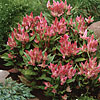New Celosia For 2004
 |
Celosia 'Fresh Look Red' Celosia plumosa
Awarded the AAS Gold Medal for outstanding garden performance and length of blooming season. The distinctive long-lived 8- to 10-inch tall rosy red flower plumes and bright green leaves make this winner a garden standout. (Grown by Benary)
 |
Celosia 'Fresh Look Yellow' Celosia plumosa
Abundance of feathery yellow plumes offer season-long garden color on vigorous 14-inch plants. The numerous side shoots and the 9-inch tall central plume can be dried as everlastings. Plants exhibit heat, humidity and severe weather tolerance. (Grown by Benary)
 |
Celosia 'Spiky Pink' Celosia spicata
Clusters of wheat-like flower spikes 3 inches long are hot pink with red stems. Plants are 15 to 18 inches tall. Heat tolerant full sun annual for containers, landscaping in hot areas and in dried arrangements. (Grown by Kieft Seeds Holland)
Care of Cockscomb
The care information provided for Cockscomb represents the kind of practical advice is available for all the plants in this web site if you subscribe to the monthly customized newsletter Yardener’s Advisor.
| Care of Cockscomb or Celosia | |
|---|---|
| March | Cockscombs are easy to grow from seed, either indoors under lights or outdoors in the garden. If direct seeding is your choice for Cockscomb, sow indoors about 6 weeks before last frost or sow seeds directly into the garden bed after all danger of spring frost is past. See Starting Plants From Seed and see Seed Starting Supplies and Equipment. |
| April | Plant Cockscomb seedlings purchased at the garden center or nursery, or those you've started indoors, as soon as danger of frost is past and the soil is warm (when night time temperatures stay above 50 degrees). See Yardener’s Helper re: hardening off seedlings before planting outside. Space plants 8 to 12 inches apart depending on expected height of the variety you are planting. |
| May | If Cockscombs are growing in good soil containing lots of organic material, they want only a light feeding in the spring when the seedlings are set out, about a half a tablespoon of slow-release granular fertilizer per plant. In poor soils use a bit more; one tablespoon of slow-release granular fertilizer per plant. That is all you need for the season. See Choosing Fertilizers in Yardener’s Tool Shed. |
| Optional task – Cockscombs grow best when mulched. As soon as the Cockscomb seedlings are tall enough, spread a 2 or 3 inch layer of some organic material such as chopped leaves, dried grass or wood chips on the soil around the plants. For more information see the file on Using Mulch | |
| June | Optional - Cockscombs sometimes need support to protect them against heavy rain, wind and passers-by. Choose unobtrusive stakes available at garden centers or find straight, sturdy sticks that are at least as tall as the eventual height of the Cockscomb plants. |
| August | Optional - Spray the foliage of flowering annuals with a dilute solution of liquid fertilizer to give them a hot weather energy boost. See Choosing Fertilizers in Yardener’s Tool Shed. |
| September | Your plants will die with the first hard frost. Remove them to the compost pile but keep the beds mulched right through the winter, ready for next year’s plants. |

